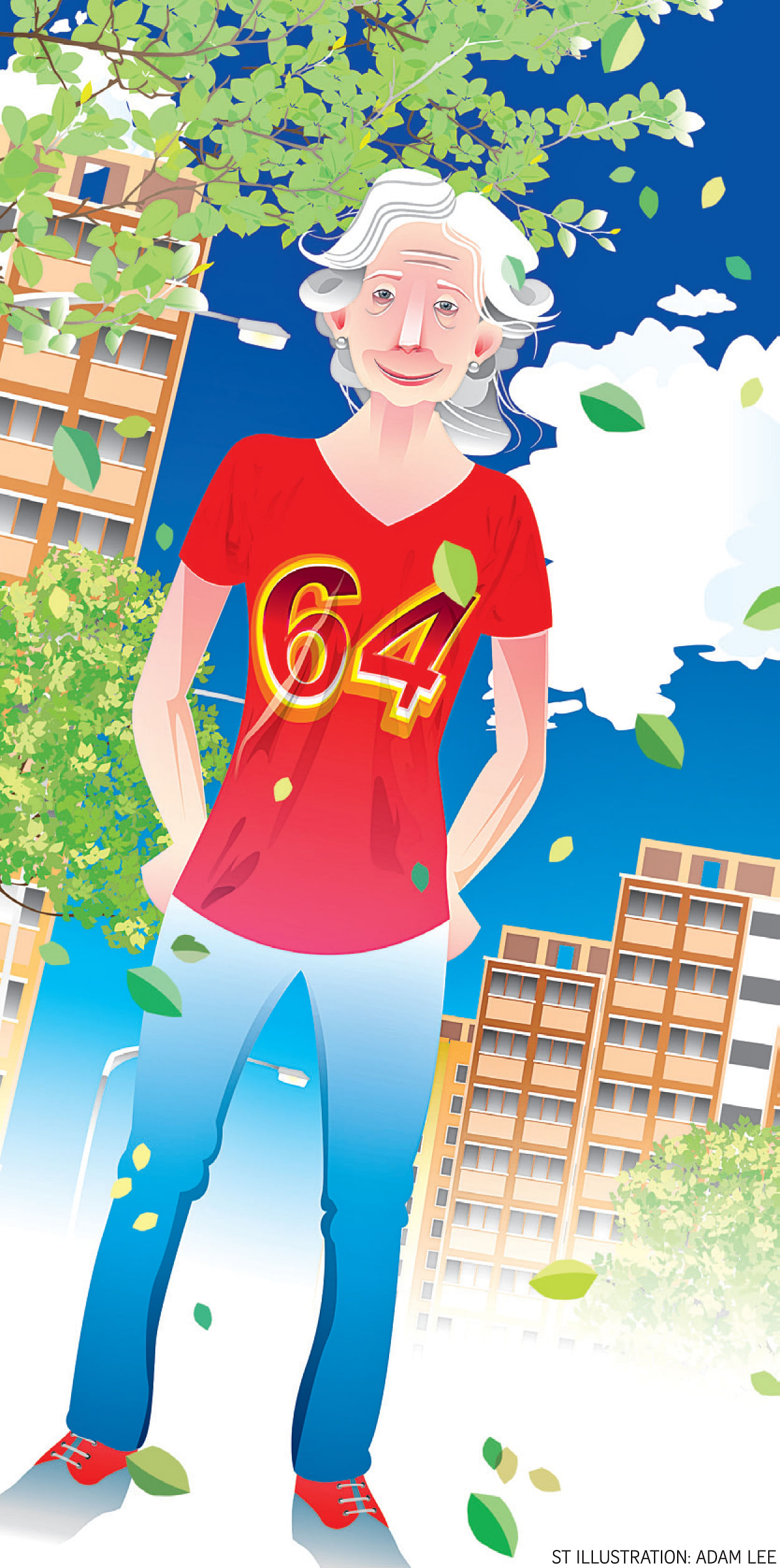As I grow into my late 40s, I find myself ruminating on what kind of Singapore this will be like to live in when I'm old.
Will I have enough to live on? What kind of home can I live in? Will there be support in daily living needs as I grow frail?
As I have no children to count on, will I have to grow old in one of those nursing homes with long rows of beds filled with sad-looking old folks? Or can I age in my own home, or my own room, among friendly people?
Last week, two issues in the news sparked both despair and hope in this area. First, hope.
After dismissing as unsustainable a care model that would let elderly people live in home-like settings in single- and twin-bedded rooms, clustered around a dining and kitchen area, the Ministry of Health (MOH) has relented somewhat.
The Lien Foundation had proposed this kind of care home last year for an existing facility, but aborted the subject when MOH refused to provide it with the usual subsidies for eldercare patients, saying it would be financially unsustainable to provide subsidies for patients living in rooms that are "designed to proxy private or A-class ward configurations such as single- or double-bedded rooms only."

Most nursing homes today have dormitory-style beds in institutionalised settings.
The Lien Foundation and the Khoo Chwee Neo Foundation got research consulting agency Oliver Wyman to research on the costs. Its consultant, Dr Jeremy Lim, wrote: "Transitioning the 5,000 nursing- home beds in the pipeline to a Jade Circle-type model would cost Singapore an additional $8 to $13 per nursing home resident per day or less than $20 million a year in total."
MOH has since said it will study the report and work with Lien Foundation. It also stressed that it "appreciates the aspiration for our seniors to age in more homely environments that provide dignified and enabling care" and would "work with providers to explore new models of care that give residents greater independence and autonomy".
I am rooting for the Lien Foundation and its partners to convince MOH to widen its fiscal horizons, and include home-like nursing homes within its funding formula.
Then, when I'm 64, perhaps I can start my "young old" days in a Housing Board flat near coffee shops and amenities. As I age and need more care, I hope to have access to home-care assistants, or nursing help, or doctor's visits, or meals in a communal dining area so I don't have to cook for myself.
As I get more frail, and advance into my "old old" age, I hope to move into a nursing home in the same block or nearby, living out my last days in a single- or twin-bedded room, decorated the way I like it, with my favourite objects around, and elderly friends nearby.
But while the Lien Foundation's advocacy gives me hope for change, I'm not holding my breath.
What I find frustrating whenever we discuss ageing issues is that there has been so much talk over the last 20 years, and not enough action.
In the 1990s, a slew of reports suggested changes to housing options, and to financing. There was much talk of sheltered housing - that lets people age in home-like surroundings, with supports for medical and living needs nearby.
In 1997, The Straits Times did a survey that I reported on. It found that four in 10 worry about housing for their old age. One-third of those with children do not want to live with them when old. Thirty-eight per cent said they could live in a retirement block within an HDB estate; 27 per cent would consider commercial retirement homes; and 14 per cent would consider a nursing home.
Even back then, 19 years ago, the nursing-home option was the choice of a mere 14 per cent. Yet, for most frail elderly that can't hire a full-time caregiver at home, that remains the only viable option today.
Singapore, in other words, hasn't moved much when it comes to caring for its frail elderly.
The Oliver Wyman research report on nursing-home economics noted that countries like Japan, that began with dormitory-style institutionalised nursing homes, have moved on to provide residents with more homely settings today. In Singapore, progress has been painfully slow.
I hope nursing-home models will change by the time I need one. I turn 62 in 2030, and will be one of the one million people who will be above 60 in 2030.
One in three of us then is projected to need some form of eldercare service by then.
The window of 14 years between now and 2030 gives me some hope for change to happen in time for when I age.
When it comes to retirement financing, however, 14 years is too short a horizon for those in my age group to benefit from whatever changes may be effected to the status quo.
Last week, a panel advising the Government on Central Provident Fund changes proposed the setting up of a series of passively managed life-cycle funds that CPF members can invest in.
This offers an alternative to their current two choices: the zero-risk, guaranteed return of keeping their monies with CPF; and the wild wild west of using their CPF funds to invest in over 200 approved unit trust and other funds under the CPF Investment Scheme (CPFIS).
Finance professor Benedict Koh (on the CPF advisory panel) wrote in The Straits Times in 2014 that 47 per cent of CPF members who had withdrawn their Ordinary Account (OA) savings to invest in the CPFIS had incurred losses on their investments between 2004 and 2013; 35 per cent realised net profits equal to or less than the default 2.5 per cent per annum OA interest rate; and just 18 per cent generated net profits in excess of the OA interest rate.
In other words, eight in 10 would have been better off, or just as well off, if they had just left their money in the CPF.
What this shows is that most of us don't make very good investment choices with our CPF funds.
This, however, shouldn't lead us to think we're better off just letting the CPF Board handle the money and being content with 2.5 per cent a year.
If one of those passively managed exchange-traded funds was available and we had just left the money there, how would we have fared?
Imagine a fund that tracked the benchmark MSCI World Index. In the last 10 years, this index grew at an annual 5 per cent a year. That's twice the OA interest rate.
How much difference would that make?
If you left $10,000 in your CPF, 10 years later, you would get $12,837. If you had put it with the index fund that generated 5 per cent, you would get $16,487.
The difference of a few thousand dollars may not sound like much. But over 30 years, it can make or break your retirement piggy bank.
Over 30 years, $10,000 at 5 per cent interest compounded monthly swells to $44,677. At the CPF rate of 2.5 per cent, you get just $21,153.
The difference is twofold.
This is the power of compound interest over time.
This is why I despaired when I read that the panel was proposing the setting up of these funds.
Proposals to set up private pension funds/ or privately managed pension funds / or private pension plans have been around since the mid-1990s. The exact nomenclature changes depending on the mood of the times and the specific suggestion, but the idea is of low-cost funds that are cheaper to run than retail unit trusts, and that offer investors a few, carefully selected, choices that match their life cycle and risk profiles.
Each time, some committee or other would recommend it, there would be lots of talk, it would be studied - then, nothing.
And after over 20 years of talk, we get another proposal. It will take a few years to study this, and another few more to operationalise this. If it even gets beyond the "study" stage.
I know retirement financing is serious business, affecting people's lives. It takes leaders with confidence and conviction to propose changes. No politician will want to get flak when the market turns, and returns dip. Citizens too will also have to understand the risks and returns, and not blame the Government if they make poor decisions. So time for considered study is important.
But each delay in action means another cohort of Singaporean workers are growing old with safe, but low returns on their CPF funds.
Each cycle of talk-explore- no-action means another generation of average workers will lead harder lives in old age.
Will this time prove different? For the sake of younger Singaporeans, I sincerely hope so.
For myself, and those of my age group, it is too late. I have seven years before I hit 55, when my Retirement Account in CPF is due to start. That is barely time to operationalise the proposal, let alone to enjoy the compounded interest that may come with higher-yield funds.
My mind goes back to the lyrics of the Beatles song When I'm 64: "Will you still need me, will you still feed me, when I'm 64?"
What I'd really like to say, though, is this: "Will you heed me, will you change for me, before I'm 64?"
I won't hold my breath for myself.
But I hope today's generation of decision-makers will take action on retirement financing, so that younger Singaporeans just building up their CPF nest eggs today will benefit from their decisive action this decade.


